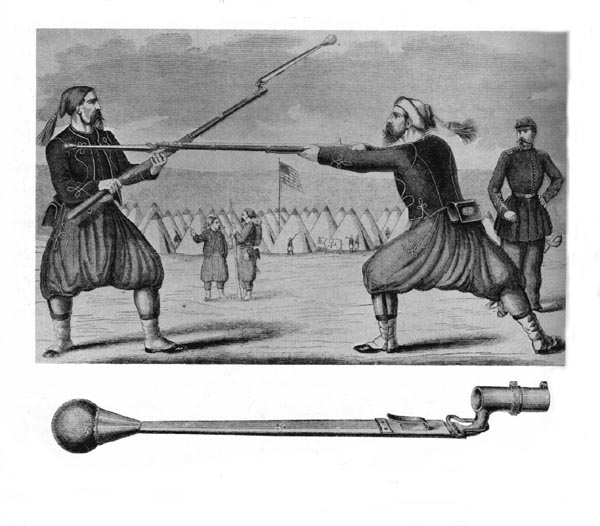What's
New - Timeline
- Articles
- Techniques
- Catalog
- Seminars
- Links
- Contact
Us
The American Training Bayonet 1858-1912
Pictures from American Bayonets 1776-1964 by A.N. Hardin,
Jr.
Bayonet History
The bayonet is a special weapon in the American
arsenal. Like the sword, the rifle bayonet harks back to the
Renaissance, where the bayonet came to replace the short spear or
pole arm. English military men in the 1600’s liked this
new weapon as “it could give hurt either near or at range”,
but the early bayonet was little more than a long dagger rammed into
the barrel of your rifle, and you could not shoot with it in
place.
By the Revolutionary War, the bayonet had
evolved into a spike about 14-18” long. Some were round,
others triangular, in cross-section, still others had more of a
“T” shaped Rib along the top, but all were similar in that
they were powerful stabbing weapons. These spike bayonet was a
popular design, and would stick with us in one form or another from
1776 all the way through to the end of the Nineteenth Century.
A second type of bayonet that became popular in
America after about 1840 or so was the sword or saber bayonet.
True to their name, these bayonets looked like small swords or
sabers, depending on how much curve they had to the blade. They
had between 20-26” blades, and were capable short-swords in
their own right. After about 1860, a new style of Bowie-knife
influenced sword bayonet also starts to be seen, which is similar to
the saber bayonet, but with a larger belly and the Bowie’s
characteristic clipped point. Though all these sword and saber
bayonets looked fierce, they were probably better utilized as hand
weapons then on a rifle.
The third major type of bayonet, seen mainly in
the closing years of the Nineteenth century, was the final evolution
and the type we still use today - the knife bayonet. These were
shorter overall than earlier bayonets, and were all capable of
functioning as a utility or fighting knife, as well. The 1898
Krag-Jorgensen model was a true Bowie knife, with a wide full blade
and upswept clip point.
Unlike the sword or knife, the bayonet as a
weapon has always been military in nature, and has never been in
popular use among civilians. To the military mind of the 19th
century, though, the bayonet was seen as the fourth form of fencing,
along with foil, eppe’, and saber. Wearing a standard
fencing mask and jacket, they practiced assaults with flexible
training bayonets made of metal or whale-bone, with the first
official training bayonets being issued in 1858. Also to this
end, several instructional manuals were written for officers,
including one by General George McClellan himself in 1862.
In training the bayonet, soldiers would learn
to affix and remove it on command and how to guard against cavalry
and infantry using the real bayonet. They also would drill the
motions of bayonet fighting as a group drill using the live
blades. When it came time to practice assaulting
(actually fighting), soldiers would wear a plastron (jacket),
mask, and gloves from fencing and use these following kinds of
blades, affixed to old service rifles.

1858 Model, with blade made of whale bone. The tip is an India
rubber ball, covered with leather. There are many nearly
identical specimens to be found from this time period, with the
blades made either of whale bone or spring steel. One design
uses a narrow spring steel blade encased in a leather sheath

1862 design from Scientific American magazine. Never
official in US Army, but shown here being used by two Zouave.
The man on the left is using a parry in tierce, while the man on the
right attacks using a thrust with development.

1906 Model, meant to fit only on a mock rifle used for training, as
opposed to using old, no longer fireable rifles.

1912 Model, also meant for use with dummy rifles.
During the 30's and 40's, the use of the Pugil
Stick in training replaced the use of the fencing bayonet for
good. The training emphasis has also shifted, and in many
quarters of the military today it's training is regarded more as a
way to simply produce aggression than to pass on fighting
techniques. The pugil stick of today is designed also with
safety in mind, and with many of them the soldiers can not release
their hands from the weapon. This causes the fight to be more
of a swinging affair than a thrusting one, and disallows the use of
many classical techniques like Lunge Out, known better in modern day
by the name John Styers gave it in Cold Steel, "Throw Point", where
the weapon's tip is thrust a great distance and retracted with one
hand. This method gives an advantage measured in feet to the
man who uses it correctly, which can be a deadly advantage in close
combat, but one sadly no longer emphasized in training, and in fact
is no longer found in the manuals for any of the US services!
What's
New - Timeline
- Articles
- Techniques
- Catalog
- Seminars
- Links
- Contact
Us